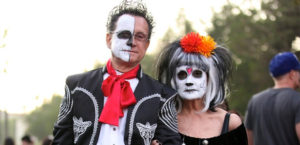Dia de los Muertos

DIA DE LOS MUERTOS –
Celebrate Dia de Los Muertos like the goddess Mictecacihuatl, the Lady of the Dead, with skull masks, make-up, decorated hats, wigs, and costumes from Etoile Costume and Party Center in Tarzana. We have make up for those who want to do their own with some great ideas you can find on our Instagram account at @EtoileCostumeAndParty.
Want someone else to do the work? You can make an appointment with one of our make-up artists whenever you need it. We have costumes to purchase as well as rental costumes for men and women. We also have an interesting selection of Dia de Los Muertos themed masks and collectibles.
 UNCONFIRMED DATES TBA
UNCONFIRMED DATES TBA
HOLLYWOOD FOREVER CEMETERY,
6000 Santa Monica Blvd., Hollywood, CA
Week long celebrations on OLVERA STREET, Downtown Los Angeles, CA
http://www.ladayofthedead.com/
Originally named El Pueblo de la Reina de Los Angeles, Los Angeles has a rich Hispanic history, with many celebrations for Dia de los Muertos (Day of the Dead) taking place throughout the city. Hollywood Forever Cemetery is the only cemetery in the country which opens its gates and welcomes guests to commemorate El Dia de Los Muertos.
In the spirit of the goddess Mictecacihuatl, known as the “Lady of the Dead,” and Samhain, the Celtic day feast of the dead, Hollywood Forever Cemetery and the merchants of Olvera Street have ingrained an emotionally driven chord with our surrounding community. By providing this genuine setting to learn the importance and significance of this celebration, tens of thousands of new and returning faithful visitors are continuously welcomed as guests and interactive participants to this annual and growing community based festivity.
Hollywood Forever Cemetery is genuinely focused on striving to bestow a memorable occasion by embracing the celebratory process of death and dying through providing a historically recognized cultural setting for this festive event and sacred observance. This community based event encompasses and visually illustrates a Pre- Columbian ancient jovial traditional view of death with a modern eclectic celebratory observance.
 Good friends of Etoile, Lincoln and Sandra, enjoying the Dia de los Muertos festivities at the cemetery in rental costumes from our racks. All the make-up supplies and instructions you’ll need to do-it-yourself, or have one of our professionals do it for you.
Good friends of Etoile, Lincoln and Sandra, enjoying the Dia de los Muertos festivities at the cemetery in rental costumes from our racks. All the make-up supplies and instructions you’ll need to do-it-yourself, or have one of our professionals do it for you.
Week long parades and work shops are also held celebrating Dia De Los Muertos by Olvera Street merchants and the El Pueblo Historical Monument. These events provide a gateway for those who wish to re-acquaint themselves with their deeply rooted traditions with one of the most devotional celebrations for the continuous cycle of life. At the heart of this sacred event are the meticulously crafted altars and spiritual shrines. These dazzling private tributes and offerings which provide a linkage between ancient traditions and modern customs chronicle the perpetual relation between faith, family and history.
Although its counterpart in Glendale is arguably more impressive, Hollywood Forever Cemetery is as Hollywood as they come. Located at 6000 Santa Monica Boulevard in the Hollywood district of Los Angeles, adjacent to the back lot of Paramount Studios, it’s genuine elegance is provided by its Egyptian temples, Greek statues and Roman memorials. This is the final resting place for some of the most famous names in early Hollywood history including Cecil B. DeMille, Douglas Fairbanks and Rudolph Valentino. The Paramount Studios lot lies adjacent to these grounds, and many of its stars have been buried here. Some of the more impressive grave sites include the water-guarded mausoleum of William A. Clark, Jr. and Douglas Fairbank’s monument and reflecting pool.
 The Day of the Dead is a holiday celebrated mainly in Latin America and by Latinos living in the United States and Canada. The holiday focuses on gatherings of family and friends to pray for and remember friends and family members who have died. The celebration occurs on the 1st and 2nd of November, in connection with the Catholic holy days of All Saints’ Day and All Souls’ Day which take place on those days. Traditions include building private altars honoring the deceased, using sugar skulls, marigolds, and the favorite foods and beverages of the departed, and visiting graves with these as gifts.
The Day of the Dead is a holiday celebrated mainly in Latin America and by Latinos living in the United States and Canada. The holiday focuses on gatherings of family and friends to pray for and remember friends and family members who have died. The celebration occurs on the 1st and 2nd of November, in connection with the Catholic holy days of All Saints’ Day and All Souls’ Day which take place on those days. Traditions include building private altars honoring the deceased, using sugar skulls, marigolds, and the favorite foods and beverages of the departed, and visiting graves with these as gifts.
Scholars trace the origins of the modern holiday to indigenous observances dating back thousands of years, and to an Aztec festival dedicated to a goddess called Mictecacihuatl. Similar holidays are celebrated in many parts of the world; for example, it’s a public holiday (Dia de Finados) in Brazil, where many Brazilians celebrate by visiting cemeteries and churches. In Spain, there are festivals and parades, and at the end of the day, people gather at cemeteries and pray for their loved ones who have died. Similar observances occur elsewhere in Europe and in the Philippines, and similarly themed celebrations appear in many Asian and African cultures.
The Day of the Dead/Dia de los Muertos celebrations in Mexico can be traced back to the indigenous Olmec Zapotec, Zaptec, Mixtec, Mexican or Aztec, Maya, P’urhepecha, and Totonac. Rituals celebrating the deaths of ancestors have been observed by these civilizations perhaps for as long as 2500–3000 years. In the pre-Hispanic era, it was common to keep skulls as trophies and display them during the rituals to symbolize death and rebirth.
The festival that became the modern Day of the Dead fell in the ninth month of the Aztec calendar, about the beginning of August, and was celebrated for an entire month. The festivities were dedicated to the goddess Mictecacihuatl, known as the “Lady of the Dead,” corresponding to the modern Catrina .
In most regions of Mexico, November 1 honors children and infants, whereas deceased adults are honored on November 2 by taunting them in their grave. This is indicated by generally referring to November 1 mainly as “Día de los Inocentes” (Day of the Innocents) but also as “Día de los Angelitos” (Day of the Little Angels) and November 2 as “Día de los Muertos” or “Día de los Difuntos” (Day of the Dead).
BELIEFS
Many people believe that during the Day of the Dead, it is easier for the souls of the departed to visit the living. People go to cemeteries to communicate with the souls of the departed, and build private altars containing the favorite foods and beverages, as well as photos and memorabilia, of the departed. The intent is to encourage visits by the souls, so that the souls will hear the prayers and the comments of the living directed to them. Celebrations can take a humorous tone, as celebrants remember funny events and anecdotes about the departed.
Plans for the day are made throughout the year, including gathering the goods to be offered to the dead. During the two-day period, families usually clean and decorate graves; most visit the cemeteries where their loved ones are buried and decorate their graves with ofrendas (offerings), which often include orange marigolds. In modern Mexico, they are often referred to as “Flor de Muerto” (“Flower of the Dead”). These flowers are thought to attract souls of the dead to the offerings.
Toys are brought for dead children (los angelitos, or “the little angels”), and bottles of tequila, mezcal or pulque or jars of atole for adults. Families will also offer trinkets or the favorite candies on the grave. Ofrendas are also put in homes, usually with foods such as candied pumpkin, pan de muerto (“bread of the dead”), sugar skulls and beverages such as atole. The ofrendas are left out in the homes as a welcoming gesture for the deceased. Some people believe the spirits of the dead eat the “spiritual essence” of the ofrendas food, so even though the celebrators eat the food after the festivities, they believe it lacks nutritional value. Pillows and blankets are left out so that the deceased can rest after their long journey. In some parts of Mexico, people spend all night beside the graves of their relatives.
Some families build altars or small shrines in their homes; these usually have the Christian cross, statues or pictures of the Blessed Virgin Mary, pictures of deceased relatives and other persons, scores of candles and an ofrenda. Traditionally, families spend some time around the altar, praying and telling anecdotes about the deceased. In some locations, celebrants wear shells on their clothing, so that when they dance, the noise will wake up the dead; some will also dress up as the deceased.
Public schools at all levels build altars with ofrendas, usually omitting the religious symbols. Government offices usually have at least a small altar, as this holiday is seen as important to the Mexican heritage.
Those with a distinctive talent for writing sometimes create short poems, called “calaveras” (“skulls”), mocking epitaphs of friends, describing interesting habits and attitudes or funny anecdotes. This custom originated in the 18th-19th century, after a newspaper published a poem narrating a dream of a cemetery in the future, “and all of us were dead”, proceeding to “read” the tombstones. Newsapers dedicate calaveras to public figures, with cartoons of skeletons in the style of the famous calavares of Jose Guadalupe Posada, a Mexican illustrator. Theatrical presentations of Don Juan Tenorio by Jose Zorrilla (1817–1893) are also traditional on this day.
A common symbol of the holiday is the skull (colloquially called calavera), which celebrants represent in masks, called calacas (colloquial term for “skeleton”), and foods such as sugar or chocolate skulls, which are inscribed with the name of the recipient on the forehead. Sugar skulls are gifts that can be given to both the living and the dead. Other holiday foods include pan de muerto, a sweet egg bread made in various shapes, from plain rounds to skulls and rabbits, for celebrating this “fiesta” often decorated with white frosting to look like twisted bones.
Jose Guadalupe Posada created a famous print of a figure that he called “La Calavera de la Catrina” (“calavera of the female dandy”), as a parody of a Mexican upper class female. Posada’s striking image of a costumed female with a skeleton face has become associated with the Day of the Dead, and Catrina figures often are a prominent part of modern Day of the Dead observances.
We are located at 18849 Ventura Boulevard, between Reseda Boulevard and Tampa Avenue, in Tarzana; a San Fernando Valley suburb of Los Angeles. Our customers come from as far away as Santa Clarita to the north, Orange County to the south, Pasadena to the East, Ventura to the West…and everywhere in between.
Tags: Costumes, costumes for adults, costumes for kids, Day of the Dead, Dia de los Muertos, el pueblo de los angeles, encino, Los Angeles, make-up, northridge, Olvera street, rental costumes, sherman oaks, sugar skulls, Tarzana, woodland hills
Trackback from your site.
